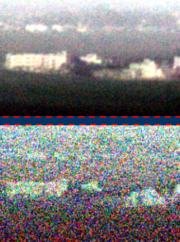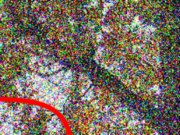Yoav Y. Schechner: Research
Resolution Loss by Pointwise Degradations

Pointwise image degradations appear in a variety of problems, such as added specular or indirect reflections, additive scattering, radiance attenuation in haze, and flash photography. These effects have no optical blur, but as we show, they induce a resolution limit. Random white noise is also a pointwise effect. We derive a resolution limit, by an effective cutoff frequency which is induced by noise and pointwise signal attenuation. The analysis uses a physical model for the acquired signal and noise, and also accounts for potential post-acquisition noise filtering. The result is in the form of probability of recovery, as a function of object spatial frequency (size), and signal-to-noise ratio (SNR). This research has also been generlized to color imaging. The framework enables assessment and optimization of abilities of an imaging system, to distinguish an object of given size and color under image noise.
As a case study, we apply this analysis to hazy images. The result is a tool that assesses the ability to recover (within a desirable success rate) an object or feature having a certain size, distance from the camera, and radiance difference from its nearby background, per attenuation coefficient of the medium. Furthermore, this analysis helped quantify the potential contribution of polarization to visibility enahcement.
Publications
- Alex Golts and Yoav Y. Schechner, “Cutoff due to pointwise degradations in color images,” Journal of the Optical Society of America - A 31:12, pp. 2711-2718 (2014).
- Tali Treibitz and Yoav Y. Schechner, “Resolution loss without imaging blur,” Journal of the Optical Society of America - A 29:8, pp. 1516-1528 (2012).
- Tali Treibitz and Yoav Y. Schechner, “Polarization: Beneficial for visibility enhancement?,” Proc. IEEE CVPR (2009).
- Tali Treibitz and Yoav Y. Schechner, “Recovery limits in pointwise degradation,” Proc. IEEE ICCP (2009).
Presentations
- “Resolution Loss without Optical Blur” (21 Mb, PowerPoint)



